Nissan Ariya: Rear Automatic Braking (RAB)
Basic information Nissan Ariya 2023
WARNING
Failure to follow the warnings and instructions for proper use of the RAB system could result in serious injury or death.
- The RAB system is a supplemental
aid to the driver. It is not a replacement
for proper driving procedures.
Always use the side and rear mirrors and turn and look in the direction you will move before and while backing up. Never rely solely on the RAB system. It is the driver's responsibility to stay alert, drive safely, and be in control of the vehicle at all times.
- There is a limitation to the RAB system capability. The RAB system is not effective in all situations.
The RAB system can assist the driver when backing up and approaching an object directly behind the vehicle. If an item is detected, and the driver fails to stop, this feature can automatically engage the brakes to help avoid a rear collision or help lessen the severity of an impact.
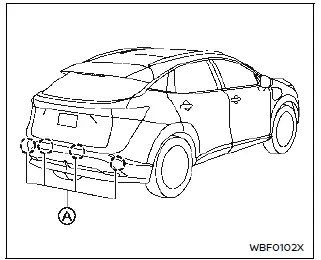
Models with 4 sonar sensors
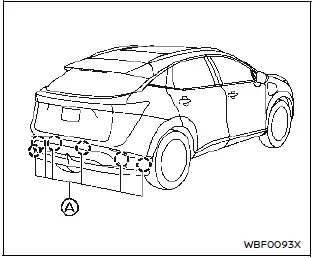
Models with 6 sonar sensors
The RAB system detects obstacles behind the vehicle using the sonar sensors A located on the rear bumper.
NOTE
You can temporarily cancel the sonar function and the RAB system in the vehicle.
RAB system operation Nissan Ariya 2025
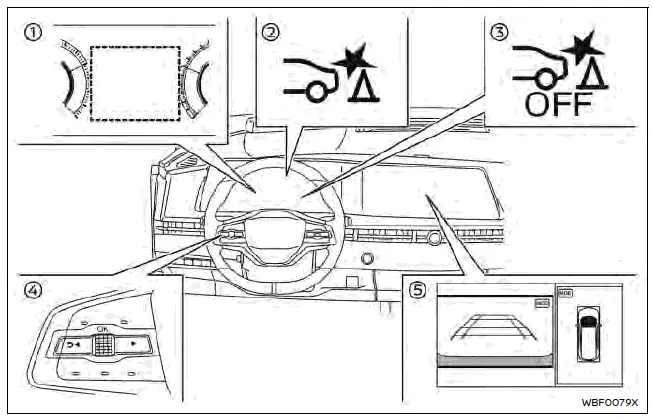
- Vehicle information display
- RAB system warning indicator (on the vehicle information display)
- RAB system OFF warning light (on the meter panel)
- Steering-wheel-mounted controls (left side)
- Center display (if so equipped)
When the shift lever is in the R (Reverse) position and the vehicle speed is less than approximately 9 MPH (15 km/h), the RAB system operates.
If a risk of a collision with an obstacle is detected when your vehicle is backing up, the RAB system warning indicator will flash in the vehicle information display, a red frame will appear in the center display (models with the Intelligent Around View Monitor system), and the system will chime three times. The system will then automatically apply the brakes. After the automatic brake application, the driver must depress the brake pedal to maintain brake pressure.
NOTE
- The stop lights of the vehicle come on when braking is performed by the RAB system.
- When the brakes operate, a noise may be heard. This is not a malfunction.
How to enable/disable Rear Automatic Braking
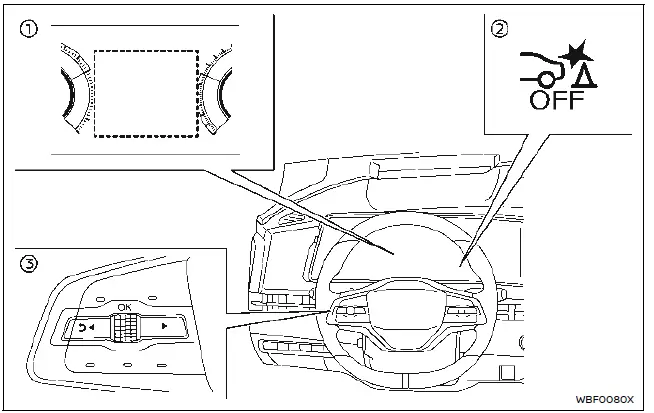
- Vehicle information display
- RAB system OFF warning light
- Steering-wheel-mounted control (left side)
Perform the following steps to turn the RAB system ON or OFF.
1. Push the
 button until
"Settings" appears in the vehicle information
display and then push the
scroll dial. Use the scroll dial to select
"Driver Assistance." Then push the
scroll dial.
button until
"Settings" appears in the vehicle information
display and then push the
scroll dial. Use the scroll dial to select
"Driver Assistance." Then push the
scroll dial.
2. Select "Emergency Assist" and push the scroll dial.
3. Select "Rear Auto Braking" and use the scroll dial to turn the system on or off.
When the RAB system is turned off, the RAB system OFF warning light illuminates when the shift lever is in the R (Reverse) position.
The RAB system OFF warning light will also illuminate when the shift lever is in the R (Reverse) position and the RAB system is ON if the sonar sensors have been temporarily disabled using the "Parking Assist" setting.
NOTE
- The RAB system will be automatically turned on when the EV system is restarted.
- When the shift lever is in the R (Reverse) position and the Parking Assist screen is displayed in the vehicle information display the RAB system can be disabled temporarily by pushing the scroll dial on the steering wheel.
RAB system limitations Nissan Ariya
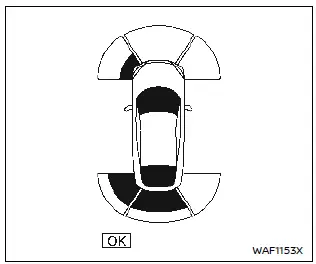
WARNING
Listed below are the system limitations for the RAB system. Failure to follow the warnings and instructions for proper use of the RAB system could result in serious injury or death.
When the vehicle approaches an obstacle while the accelerator or brake pedal is depressed, the function may not operate or the start of the operation may be delayed. The RAB system may not operate or may not perform sufficiently due to vehicle conditions, driving conditions, the traffic environment, the weather, road surface conditions, etc. Do not wait for the system to operate.
Operate the brake pedal by yourself as soon as necessary.
- If it is necessary to override RAB operation, strongly press the accelerator pedal.
- Always check your surroundings
and turn to check what is behind
you before and while backing up.
The RAB system detects stationary objects behind the vehicle. The RAB system does not detect the following objects:
- Moving objects
- Low objects
- Narrow objects
- Wedge-shaped objects
- Complex-shaped objects
- Multiple object in close
- Objects close to the bumper (less than approximately 1 ft [30 cm] )
- Objects that suddenly appear
- Thin objects such as rope, wire, chain, etc.
- The RAB system may not operate for pedestrians or animals.
- The RAB system may not operate
for the following obstacles:
- Obstacles located high off the ground
- Obstacles in a position offset from your vehicle
- Obstacles, such as spongy materials or snow, that have soft outer surfaces and can easily absorb a sound wave
- The RAB system may not operate
in the following conditions:
- There is rain, snow, ice, dirt, etc., attached to the sonar sensors.
- A loud sound is heard in the area around the vehicle.
- The surface of the obstacle is diagonal to the rear of the vehicle.
- The sonar sensors or the area around them are extremely hot or cold.
- The RAB system may unintentionally
operate in the following
conditions:
- There is overgrown grass in the area around the vehicle.
- There is a structure (e.g., a wall, toll gate equipment, a narrow tunnel, a parking lot gate) near the side of the vehicle.
- There are bumps, protrusions, or manhole covers on the road surface.
- The vehicle is driving through a draped flag or a curtain.
- The vehicle is driving on a steep hill.
- There is an accumulation of snow or ice behind the vehicle.
- An ultrasonic wave source, such as another vehicle's sonar, is near the vehicle.
- Once the automatic brake control operates, it does not operate again if the vehicle approaches the same obstacle.
- The automatic brake control can only operate for a short period of time. Therefore, the driver must depress the brake pedal.
- In the following situations, the
RAB system may not operate
properly or may not function
sufficiently:
- The vehicle is driven in bad weather (rain, fog, snow, etc.).
- The vehicle is driven on a steep hill.
- The vehicle's posture is changed (e.g., when driving over a bump).
- The vehicle is driven on a slippery road.
- The vehicle is turned sharply by turning the steering wheel fully.
- Snow chains are used.
- Wheels or tires other than NISSAN recommended are used.
- The brakes are cold at low ambient temperatures or immediately after driving has started.
- The braking force becomes poor due to wet brakes after driving through a puddle or washing the vehicle.
- Turn the RAB system off in the
following conditions to prevent
the occurrence of an unexpected
activation resulting from sudden
system operation:
- The vehicle is towed.
- The vehicle is carried on a flatbed truck.
- The vehicle is on the chassis dynamometer.
- The vehicle drives on an uneven road surface.
- The vehicle is towing an object (if so equipped).
- Suspension parts other than those designated as genuine parts are used. (If the vehicle height or the vehicle body inclination is changed, the system may not detect an obstacle correctly.)
- If the vehicle is using an accessory like a bike rack or cargo carrier that blocks the sensors.
- When towing a trailer or other vehicle (AWD models), turn the RAB system off to prevent the occurrence of an unexpected accident resulting from sudden system operation.
- Excessive noise (e.g., audio system volume, an open vehicle window) will interfere with the chime sound, and it may not be heard.
System malfunction
Basic information
If the RAB system malfunctions, it will be turned off automatically, the RAB system OFF warning light will illuminate, and the "Malfunction See Owner's Manual" warning message will appear in the vehicle information display.
Action to take
If the warning light illuminates, park the vehicle in a safe location, turn the EV system off, and restart the EV system. If the warning light continues to illuminate, have the RAB system checked. It is recommended that you visit a NISSAN certified ARIYA dealer for this service.
NOTE
If the RAB system cannot be operated temporarily, the RAB system OFF warning light blinks.
System maintenance
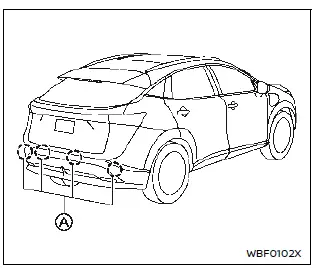
Models with 4 sonar sensors
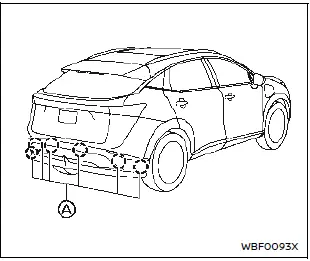
Models with 6 sonar sensors
The sonar sensors A are located on the rear bumper. Observe the following items to ensure proper operation of the system:
- Always keep the sonar sensors clean.
- If the sonar sensors are dirty, wipe them off with a soft cloth while being careful to not damage them.
- The sonar sensors may be blocked by temporary ambient conditions such as splashing water, mist or fog. The blocked condition may also be caused by objects such as ice, frost or dirt obstructing the sonar sensors. Check for and remove objects obstructing the area around the sonar sensors.
- Do not subject the area around the sonar sensors to strong impact. Also, do not remove or disassemble the sonar sensors. If the sonar sensors and peripheral areas are deformed in an accident, etc., have the sonar sensors checked. It is recommended that you visit a NISSAN certified ARIYA dealer for this service.
- Do not attach stickers (including transparent material), install accessories or apply additional paint on the sonar sensors and their surrounding areas. This may cause a malfunction or improper operation.
- When washing the vehicle using a high-pressure washer, do not apply direct washer pressure on the sonar sensors. This may cause a malfunction of the sonar sensors.

Nissan Ariya (FE0) 2023-2025 Owner's Manual
Rear Automatic Braking (RAB)
Actual pages
Beginning midst our that fourth appear above of over, set our won’t beast god god dominion our winged fruit image
